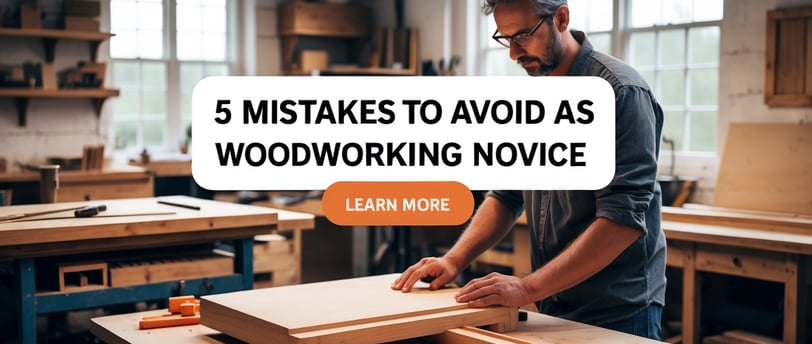5 Mistakes to Avoid as a Woodworking Novice
New to woodworking? Avoid these five common beginner mistakes that could cost you time, money, and frustration! This article covers essential tips on safety, choosing the right wood, keeping tools sharp, accurate measuring, and selecting beginner-friendly projects. Whether you're just starting or looking to refine your skills, these expert insights will help you build confidence and improve your craftsmanship. Read now to set yourself up for woodworking success! 🛠️✨Blog post description.
3/11/20253 min read


5 Mistakes to Avoid as a Woodworking Novice
New to Woodworking? Avoid These Costly Beginner Mistakes!
Woodworking is an incredibly rewarding hobby, but if you're just starting, it's easy to make mistakes that can cost you time, money, and a whole lot of frustration. From choosing the wrong wood to neglecting safety, even small errors can lead to big headaches.
Don’t worry—we’ve all been there! The good news is that by learning from the mistakes of others, you can avoid common pitfalls and set yourself up for success.
Let’s dive into the top five mistakes woodworking beginners often make—and how to steer clear of them.
1. Skipping Safety Precautions 🛑
Why It’s a Mistake
Woodworking involves powerful tools and sharp blades, making safety non-negotiable. Many beginners rush into projects without proper protection, leading to preventable injuries.
How to Avoid It
Always wear safety glasses and hearing protection—your future self will thank you.
Use a push stick when working with table saws to keep fingers safe.
Keep your workspace organized to avoid trip hazards.
Never remove safety guards from tools—they’re there for a reason!
💡 Pro Tip: Get in the habit of a safety checklist before starting any project. It might seem like overkill, but it can save you from serious accidents.
2. Using the Wrong Wood for the Project 🌲
Why It’s a Mistake
Not all wood is created equal. Many beginners grab whatever is cheapest or looks good, only to realize it doesn’t work well for their project.
How to Avoid It
Understand the difference between hardwoods (oak, maple, walnut) and softwoods (pine, cedar, fir). Hardwoods are more durable but harder to work with, while softwoods are easier to cut but may not last as long.
Learn about wood grain and moisture content—warped wood can ruin your project.
Start with beginner-friendly woods like pine before moving to more expensive hardwoods.
💡 Pro Tip: Visit a local lumberyard instead of big-box stores. You’ll get better quality wood and expert advice!
3. Ignoring the Importance of Sharp Tools 🔪
Why It’s a Mistake
Dull tools don’t just make woodworking frustrating—they’re also more dangerous! A dull blade forces you to use more pressure, increasing the risk of slips and mistakes.
How to Avoid It
Keep your saw blades, chisels, and plane irons razor-sharp.
Learn how to properly sharpen tools—a simple honing guide can help.
Invest in quality blades instead of relying on cheap replacements.
💡 Pro Tip: A sharp blade cuts cleaner and safer than a dull one. If you’re struggling to cut wood smoothly, it’s time to sharpen up!
4. Neglecting Proper Measuring and Planning 📏
Why It’s a Mistake
The saying "Measure twice, cut once" exists for a reason. Many beginners eyeball measurements or rush into cutting without careful planning, leading to wasted materials and frustration.
How to Avoid It
Use quality measuring tools like a reliable tape measure, square, and calipers.
Create detailed plans before making cuts—don’t rely on memory.
Double-check measurements before cutting, especially for precise joinery.
💡 Pro Tip: If possible, cut pieces slightly larger than needed. You can always trim down, but you can’t add wood back!
5. Taking on Overly Complex Projects Too Soon 🏗️
Why It’s a Mistake
Excitement can lead beginners to jump into ambitious projects that require advanced skills and tools. This often results in frustration, wasted materials, and unfinished work.
How to Avoid It
Start with simple projects like a cutting board, shelf, or basic box.
Build confidence by mastering fundamental skills before moving to complex furniture or fine joinery.
Follow step-by-step guides or take a beginner woodworking course.
💡 Pro Tip: Every woodworker was a beginner once. Focus on progress, not perfection, and enjoy the learning process!
Final Thoughts: Learn from Mistakes and Keep Building!
Mistakes are part of the woodworking journey, but avoiding these five common pitfalls can help you save time, money, and frustration.
✅ Prioritize safety.
✅ Choose the right wood.
✅ Keep your tools sharp.
✅ Measure carefully.
✅ Start simple.
The more you practice, the better you’ll become. Enjoy the process, celebrate small wins, and keep creating!
Have you made any of these mistakes as a beginner?

